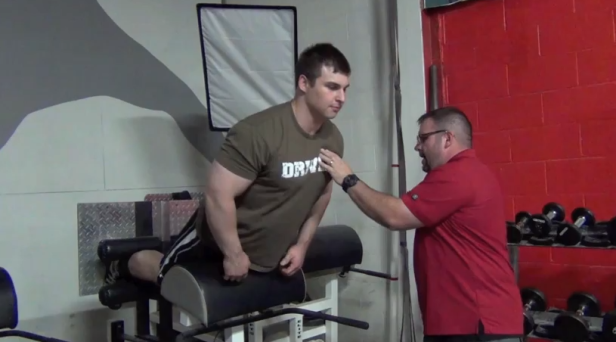
Elitefts™ Education Director Mark Watts explains two variations of the Glute-Ham Raise while Derek Dolgner demonstrates. These two variations using the elitefts™ Deluxe GHR all overload the eccentric contraction of the lift by either changing the center of gravity (COG) of of the lifter, adding an external load during the eccentric portion of the lift, or both.
The Glute-Ham Raise is one of the most beneficial movements athletes and lifters to enhance performance and reduce the chance of injury. Some of the benefits of the Glute-Ham Raise include but are not limited too:
Enhancement of Linear Speed
The Glute-Ham Raise exercise activated the posterior chain muscular in a similar firing pattern at sprinting and jumping
Vertical Jump Improvement
Because the Glute-Ham Raise is a Closed-Chain movement, it develops the ability of the athlete to produce force into the ground when doing so against the foot plate of the GHR.
Reduction in Non-Contact Lower Extremity Injuries.
The Glute-Ham Raise is one of the most efficient movements to address muscular imbalances between the posterior chain with the quads and hip flexors. Minimizing this imbalance can reduce the chance of hamstring strains and knee injuries.
Improvement in squat variations and pulls.
Increasing the strength of the glutes and hamstrings can allow the lifter to compensate less and assist in maintaining proper posture and movement patterns.
Two Variations Used in this Video
For any of these variations, a pause between the eccentric and concentric contractions can be implemented to reduce the stretch reflex and make the exercise more difficult.
1.) Changing the Center of Gravity (COG).
Hand placement can have a significant effect of the level of difficulty of the movement. This video has 3 different levels either using just the hands, a med ball, or a plate.
- Hands to the sides (not on video)
- Hands across chest
- Hands behind head
- Hands overhead
2. ) One & One-Half Reps
There are two versions of this variation. Both can be used to address the athlete's weak points and work around problem areas from a prior injury. This can also control volume and increase intensity by increasing the time-under-tension (TUT) for each rep.
- Perform Full-Rep, then half-way down. That's one.
- Perform Half Rep, then full reps, That's one
General Tips for the Performing the Glute-Ham Raise
The Set-Up
- You should feel like your knees are falling through the front pad, This will ensure the best range of motion and avoid any undue pressure on the knee.
- Your entire foot should be against the back plate. This is crucial to proper execution of the movement. Your shin should be resting on the bottom leg piece. There is no need to contact the top piece with your calf.
- The back leg adjustment should be as low as possible to start with. Raising the back apparatus will make the exercise more difficult, but it can also alleviate quad pain if needed.
The Movement
- With the Eccentric portion, concentrate on leading with your hips on the way down until your knees are locked. You should never bend at the waist at any point
- Do not perform a back rise and GHR combo. The momentum plus the tendency of extending the back to initiate the movement defeats the purpose of the lift.
- During the concentric portion, tuck your chin (to avoid leading with hyper-extension), snap your head back and push your toes against the back plate. If you are set up correctly, your ankle will be close to (not exactly) a dorsi-flexed position. This movement if done correctly activates a similar firing sequence of motor units as sprinting.
Variations
There are a few variation you can do in increase the difficulty of the lift without adding resistance. Here are some ideas.
- Pause GHRs (pause at bottom)
- Segmented (pause halfway up and down)
- Tempo (especially on eccentric)
- One & one-half reps (full rep then halfway down)
- Overload eccentrics (change COD by hand placement)








